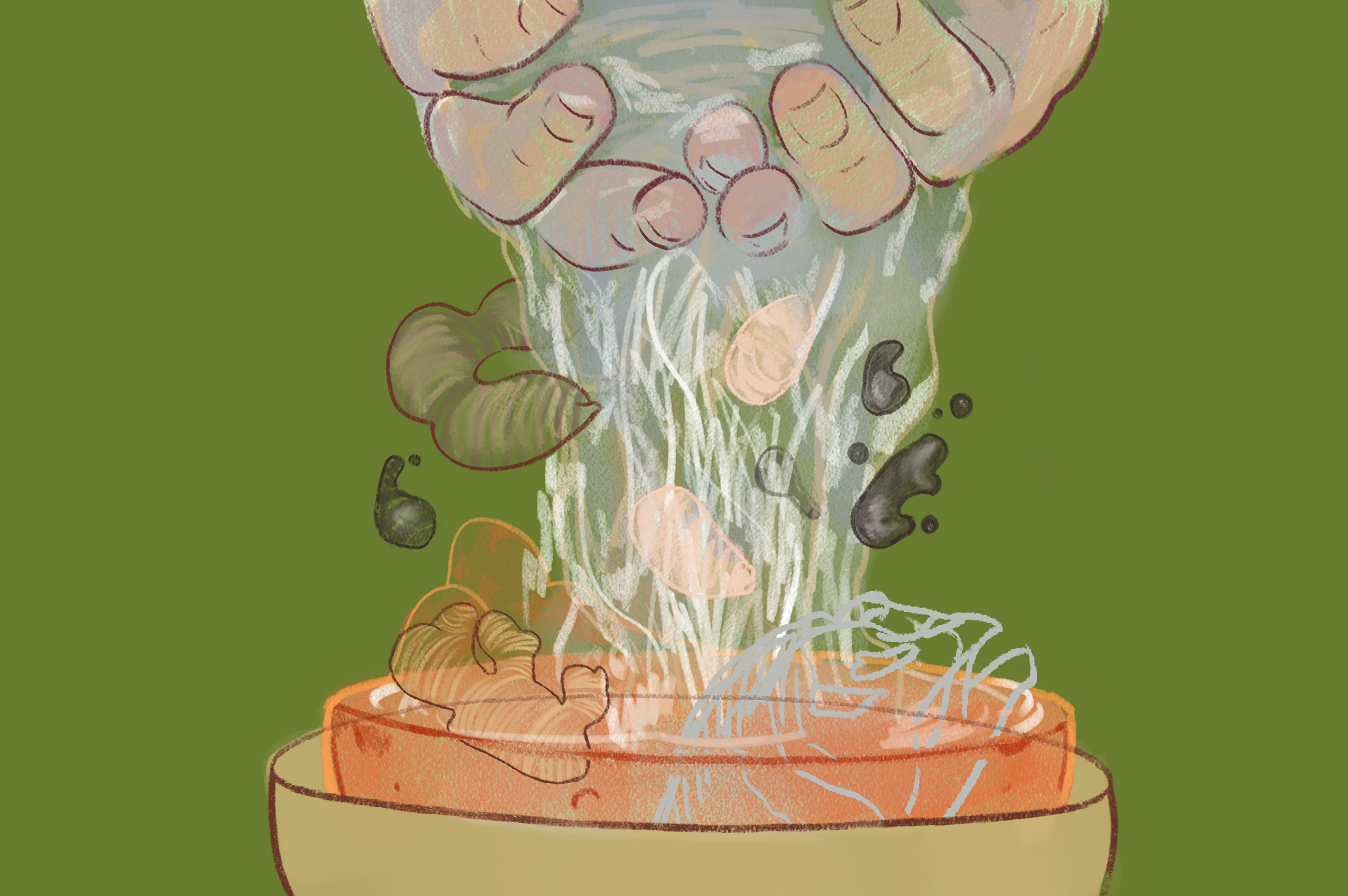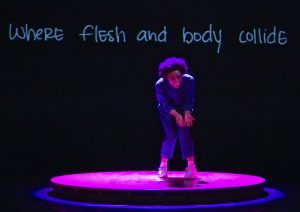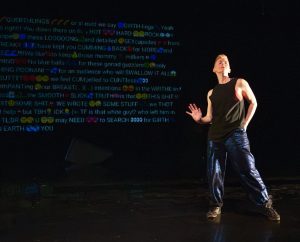I recently had the opportunity to be fed by Devyn Mañibo at a performative four-course meal she hosted at Extase Gallery in collaboration with Marie Ségolène and Jake Collings called MARROW, a communion in excavation. I’ve wanted to talk to Devyn about the way she utilizes food and cooking for connection and dissection since coming across documentation of a feast she hosted as part of her ongoing project F(E)AST at Ground Level Platform/SAIC earlier this year. The photos featured vibrant green banana leaves as a table spread holding up brilliant citruses, mounds of white rice, and cross-hatched mangoes with guests using their hands to engage with the servings. The environment she built and served made people pay attention to their food, to examine each material in relation to others on the table by way of color, texture, flavor, or purpose.
The first thing I noticed in the setting for MARROW was a flower in the centerpiece of the table. It looked like a sunflower that swallowed an artichoke, sharp and demanding with many layers in its petals. It sat in a vase on top of a light wooden rectangular platform which all of the guests would sit around. It resembled a sort of stage for the impending meal and was clean, with silverware arranged in the center and menus out, giving us an idea of what to anticipate. MARROW began with a chunk of bone filled with bitter parsley, carrot top, and lemon gremolata and lined with irregular, juicy flesh on its sides. I ate it using my hands and when all the meat had been ripped off and only a hollow bone remained, I felt like a true paleontologist before wiping my oily fingers on hanging white sheets surrounding the table leaving indelible traces of the dish on display.
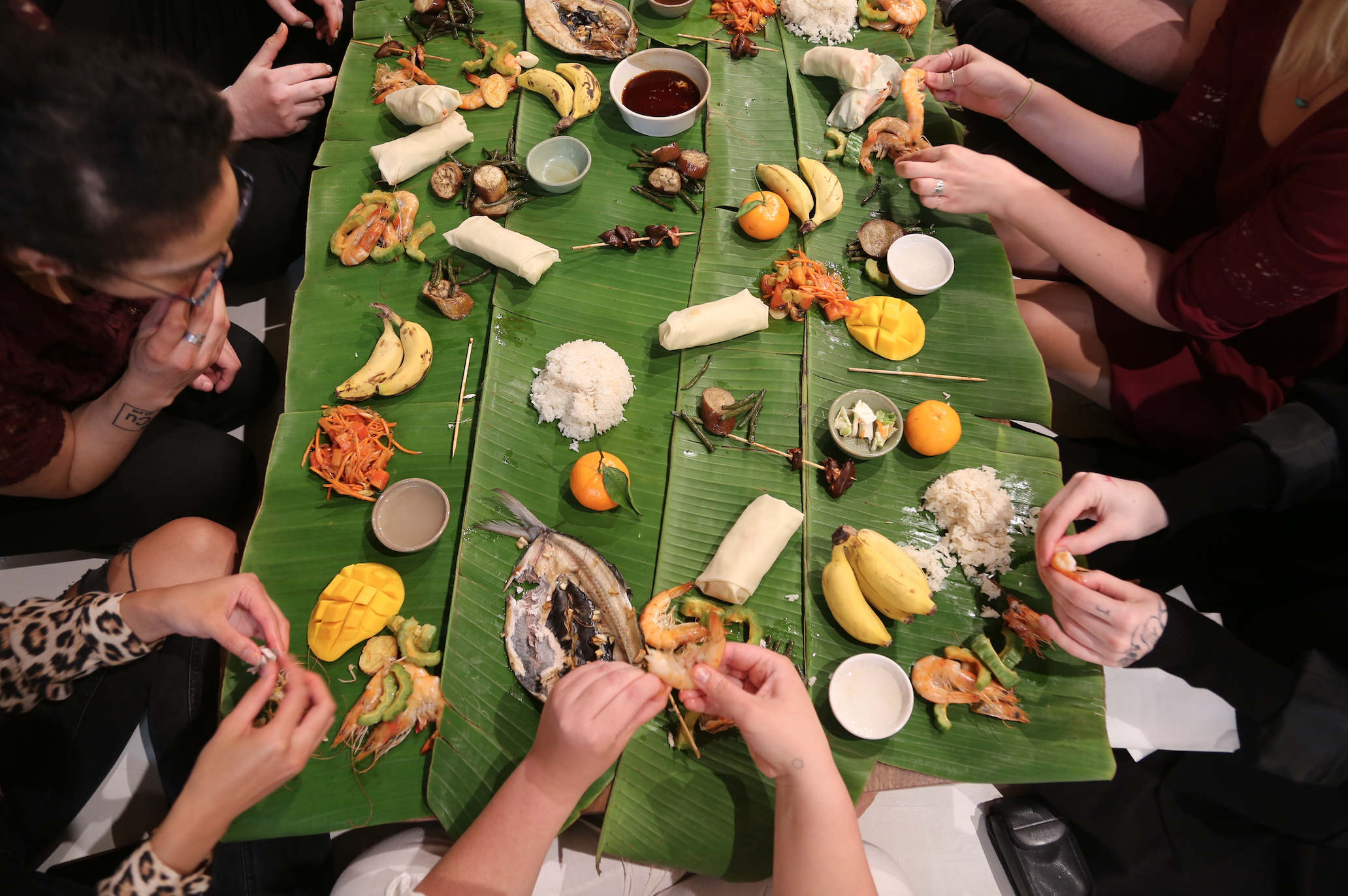
This interview took place via email and has been edited for clarity and flow.
MS: Can you tell me about your forthcoming collection of poetry and performances that culminate in F(E)AST?
DM: F(E)AST is an ongoing project which formally began on the first day of the 2019 Lenten season. The project works through what it means to feast and what it means to fast, to make from both my loneliest and fullest self, to move through both abundance and loss, to think about grief and ecstasy as operating from the same place. I gave myself the constraint of Lent in thinking about the number 40 as it relates to processes of mourning, the way we grieve for forty days after a significant death.
Additionally, I think about the way this number relates to my lineage. I am 20 years younger than my mother, and my cousins are 20 years younger than me. My mother always said she’d never make it past 40. She lived until she was 45. I wrote every day for the 40 days of Lent, whether it was a full poem, a line, or a word, I was writing – mostly about food – sense memory, body memory, alchemy.
The drafts of these written pieces were pulverized with rice water and turned into 40 squares of paper, which were then dried and embroidered with gold thread. Nine days before Easter, I hosted an intimate meal to be shared with hands. I spread banana leaves draped over a long table, low to the ground, 20 of us gathered, 40 hands gathered in communion.
On Easter Sunday, I installed the embroidered paper in a grid and placed it in a way where the words could be read in any direction. Fresh banana leaves were draped in front, completely concealing the paper. Throughout the duration of the show at SAIC’s Sullivan Galleries, the leaves dried and retracted, changing from a verdant green to bruised and browned, slowly revealing the embroidery. The pieces of paper were de-installed on what would be my mother’s 47th birthday, and will serve as the front and back covers of an edition of 20 hand bound chapbooks of the 40 pieces of writing. This chapbook will grow over the next year into a full-length poetry collection.
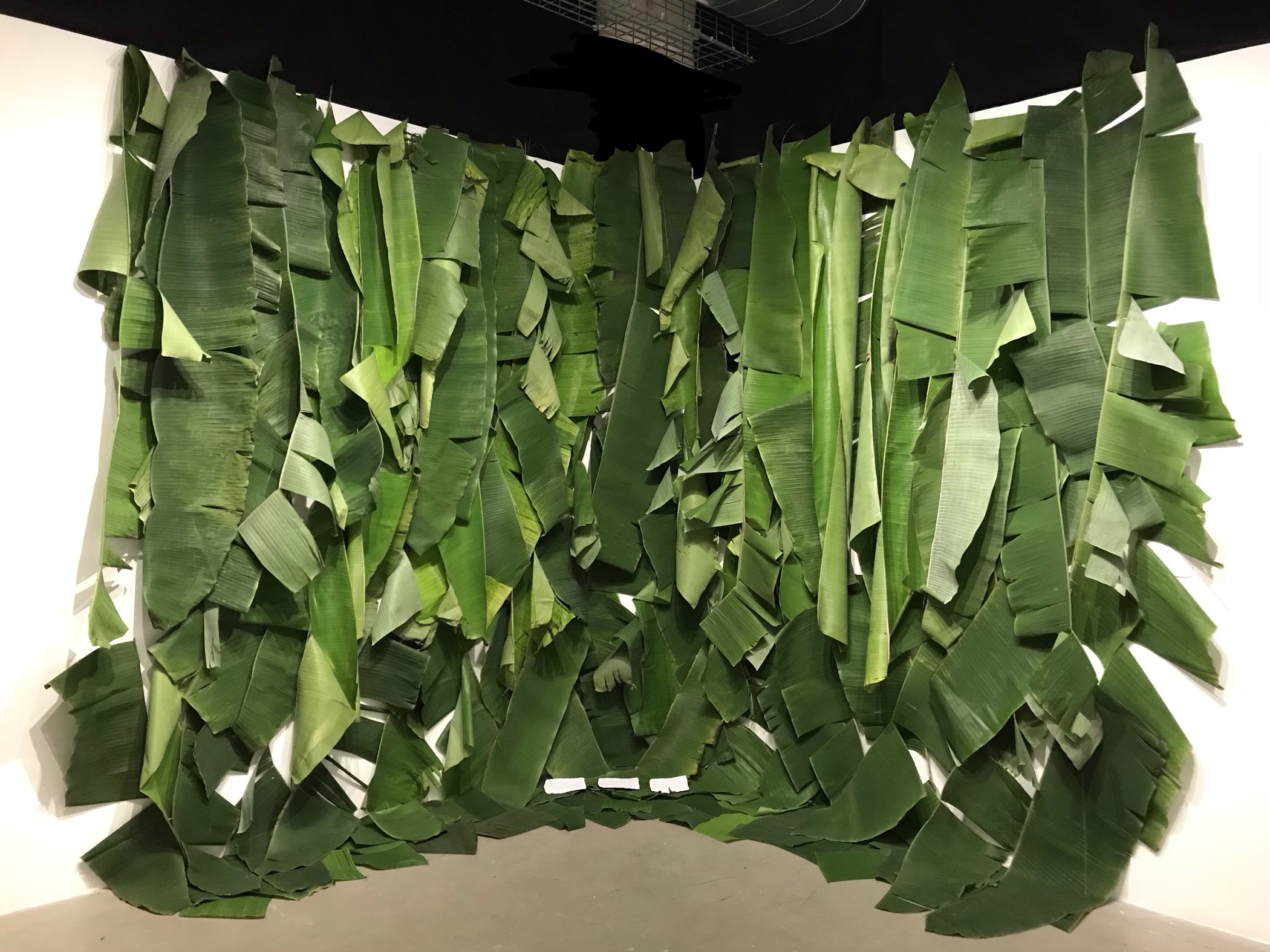
MS: How did you choose the foods for the feast you held at SAIC?
DM: I based my meal primarily on a traditional Friday Lenten meal where we abstain from eating poultry and red meats. I wanted both seasonal produce and produce traditionally used in Filipino cooking to be at the forefront, as well as a selection of seafood. The dishes were seasoned in ways that highlighted the natural flavors and textures of the ingredients, focusing on shapes, textures, and the experience of eating hand to mouth.
The meal commenced with a small bowl of sabaw (broth), the base of a Filipino soup called sinigang. The broth was cooked over a period of 6 hours, layering tamarind pods, ginger, garlic, fish bones, and upo (elongated variety of calabash or bottle gourd), and finished with soy sauce and fish sauce for a bit of saltiness. Much of it is trial and error, tasting as the hours pass, and waiting for the flavors to bloom and expand. This hot broth alone encompassed all of the flavors experienced throughout the meal, but in a singular sip. The taste of sinigang is one that brings immense comfort, remembering the way my nanay or my lola would spoon the broth over rice, chicken falling off the bone, accidentally biting right into chunks of ginger.
Time is absolutely the most important ingredient in all of my work. In some ways, it’s related to the numbers in the liturgical calendar, or numbers associated with periods of mourning, but other times they are attached to periods of waiting I’ve experienced, or ages, or spaces between bodies. There is a quietness too, that goes hand in hand with the slowness. Often, a work seems dormant, but it is doing it’s own labor without my hand.
The next course of MARROW was brought out on a long wooden board by our hosts who read out poems written for the occasion before we delved into the bounty. Set before us were whole globes of charred artichokes, long strips of asparagus piled up in heaps, carrots loaded with harissa and honey, and thick, crispy slices of country bread, blackened at the crusts. Soon, the porous wooden table we sat around was littered with gouged out artichoke leaves and stained with lines of oil where people let their food rest before eating, increasingly leaving evidence of our meal.
MS: How did you learn to cook or assemble ingredients?
DM: Everything I cook, everything I make with my hands, is an approximation. I almost never work from recipes, but rather I work from ratios and flavor profiles I’ve learned from observation and taste memory. For this meal [as part of F(E)AST], I worked with the four basic notes most present in Filipino cooking: sour (vinegar, lime), salt (soy sauce, msg), sweet (sugar, coconut), and spice (ginger, garlic)–the ratios of these ingredients and the ways they’re combined with seasonal produce and seafood changes how and where they hit the tongue and the memories they re/produce. Each dish I make is a process of layering, of tasting and tasting again.
This reminds me of the layering Devyn does with the banana leaves that decompose to reveal the next layer of embroidery on paper. With this work, it almost feels like abdicating control is necessary to get to that next layer. Rather than a result of moldering, decomposition can be something thoughtful, intentional. Instead of viewing decomposition from a position of loss, Devyn recognizes it as mandatory and inevitable.
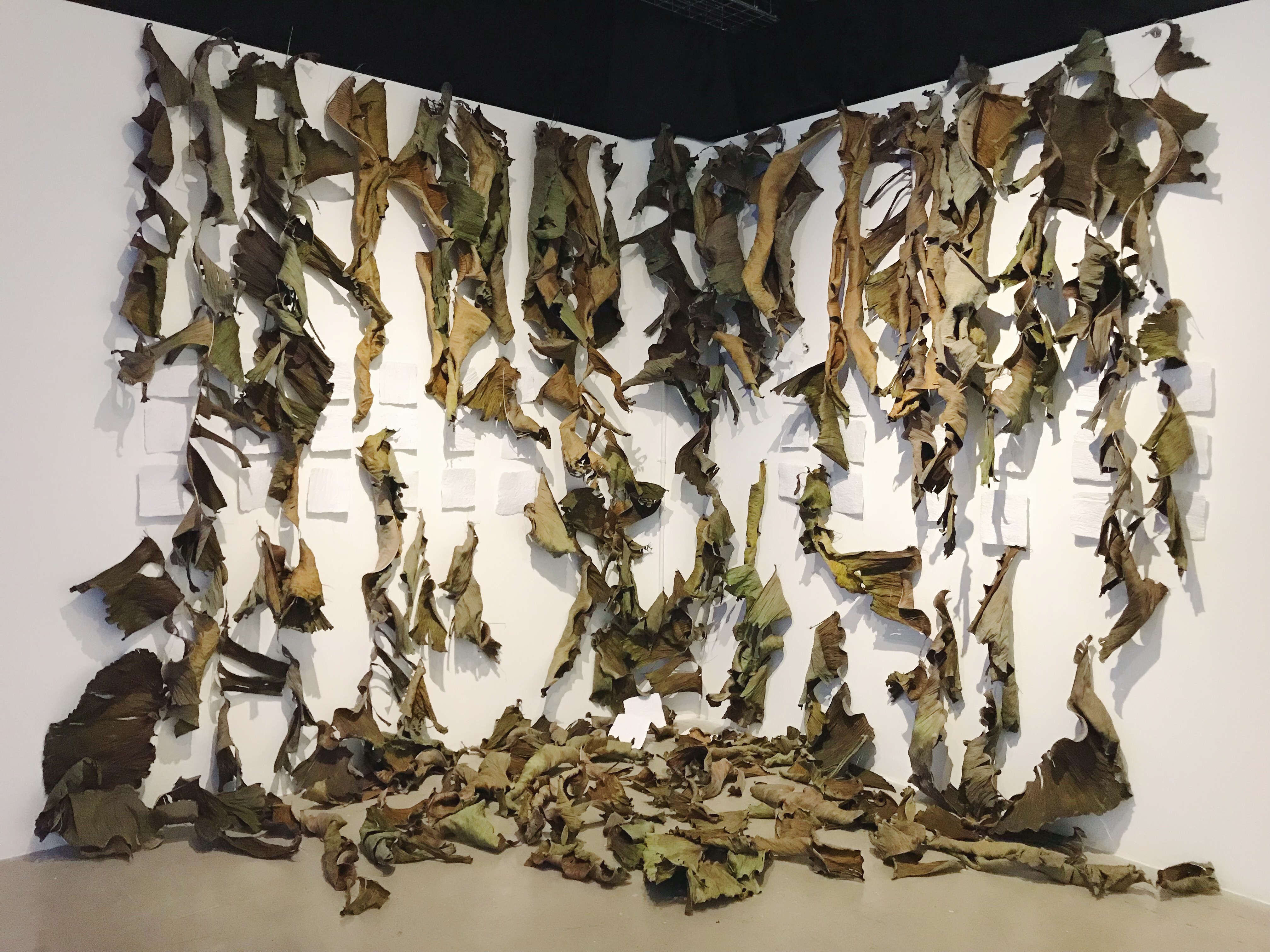
MS: What flavors, textures, or colors interest you right now?
DM: I’m interested in the color green, in produce, the ways natural materials decompose. I think about Natalie Diaz invoking Lorca, “Verde que te quiero verde” – this want for life, for verdancy, but decomposition is out of our control. The work I make is not about coming to terms with loss, but rather, a relinquishing of power over what we cannot preserve.
MS: When you relinquish power and let organic materials decompose, what else can be revealed or accessed? Can the decomposing matter give “nutrients” to what is beneath it?
DM: Totally. The ways my works are in conversation with each other in itself is a layering; how am I playing off of the affective nature of one work to the next, both thematically, and materially? So much of my work prior to F(E)AST was about “controlled” experiments in working through grief. Of course experiments have an element of control in their processes by tending to the objects daily, by dipping or spraying, or salting, but through this, the outcome is still left to chance. With these new works, I focused more on what was ultimately out of my hands. What does it mean to release that grief from your body as a material object, an object made with your hands, but to be meddled with no longer? To physically leave a space and to not visit it again until it reached its final stages of decomposition. I think for me, it’s about how the decomposing matter can give what is beneath it space, light, and breath, which is not necessarily life or nutrients.
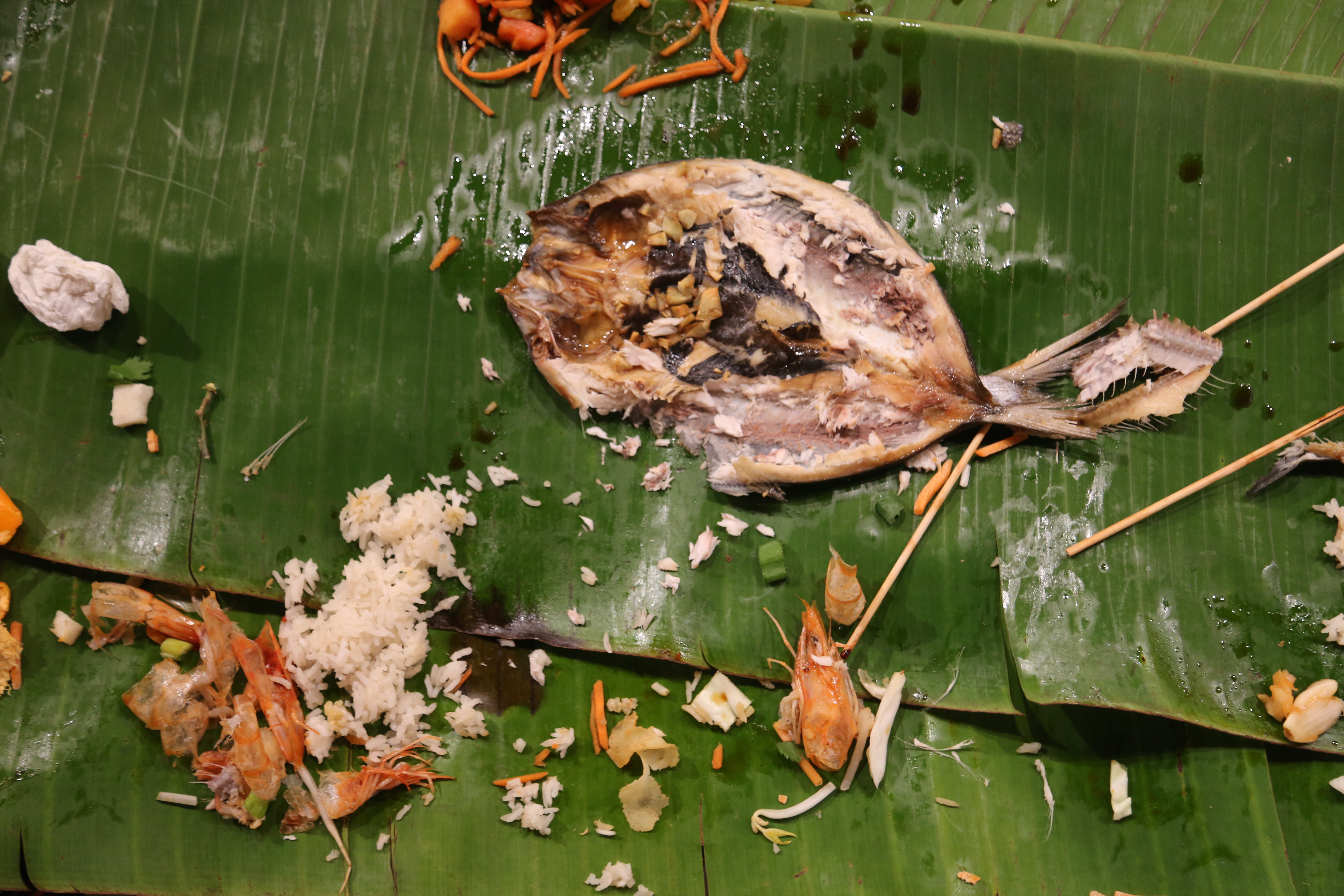
Devyn’s thoughts on decomposition remind me that produce which is harvested is subject to decomposition, while what is left, rooted, can often carry on living. In this way, harvesting can feel like a forced separation from the root. I think this narrative gets problematically utilized as a metaphor for migrant identity where members of a diaspora are seen as clippings from an original source, tasked with finding a preservative or a new ground and rooting themselves in it before decomposition sets in.
MS: How does removing produce from the ground and putting it on a surface for people to eat from change the materials, the source of the produce, or the meal you’re having?
DM: For me, it a process of filling yourself and others with the nutrients that have served us for centuries, thinking about the ways so many of these ingredients get pushed out of our diets because of lack of availability or even an ingrained distaste. I think about my lolo’s garden in Jersey City often, the way he intentionally grows upo, eggplant, and long beans, because he knows they are harder to come by in the states. His harvest is glorious and bountiful, and there is a sense of pride and rootedness in that.
Before working on F(E)AST, Devyn conducted several controlled experiments with salt where she grew salt crystals in her studio and visited the salt flats in Death Valley, which formed from dried up lakes in the region, for geological research. I know salt as a mineral we use in much of our food, from seasoning a fried egg to sprinkling over raw eggplant and watching it sweat beads of its bitterness before cooking. I never considered its grandiosity, at a scale big enough to dry out entire basins of water. It makes salt feel powerful and maybe a little evil. I was curious as to how Devyn utilized her research in the salt flats, and how she came to use it for experiments in growth rather than dehydration.
MS: Why did you want to work with salt, specifically in controlled experiments and grow it into crystals?
DM: In thinking about the ways that nothing about grief is in your control, I wanted to create methods of processing my mourning that were two fold: to create distance from my physical body while still utilizing elements present in the body, as well as to give myself a repetitive task to complete as to come to a sense of “closure,” though this was the more unrealistic outcome.
MS: How does this work with the narrative of salt as a sort of residue or underlying material once grief has dried?
DM: Grief never actually dries, right? If anything, it sediments. We’re left with layers and layers of memory, a hardening of what residue we have.
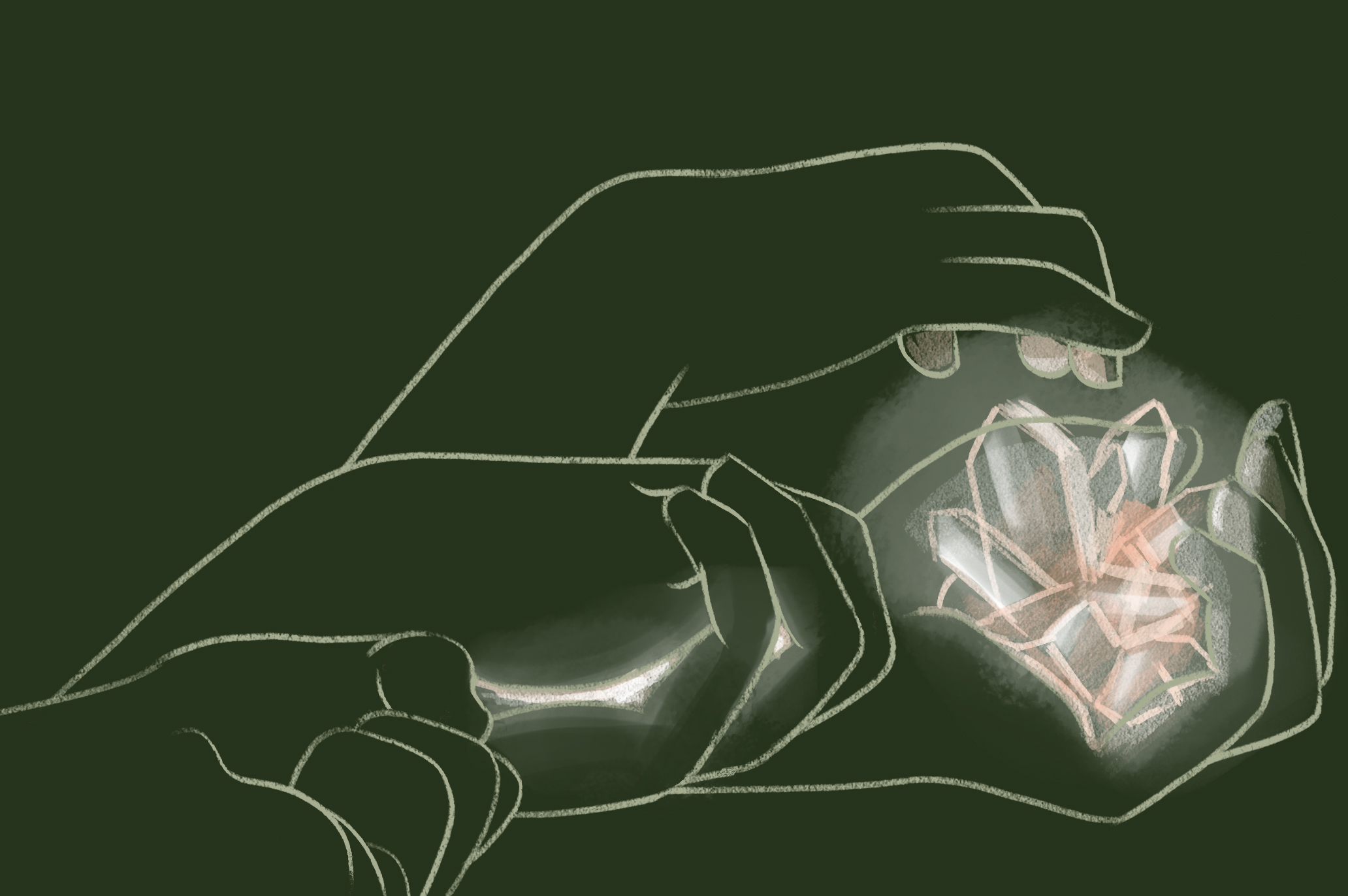
MS: As an ingredient used for preservation, how does salt function in a diaspora?
DM: So much of the ways I’ve worked through grief in my work has utilized bodies of water as core to my thinking. Specifically, thinking about the Pacific Ocean as a metaphor for grief, both a container and a flowing yet seemingly impenetrable barrier between my body and the bodies that have held me, whether that’s referring to the ancestral or the geographical. In thinking about coming to terms with grief, I ask the question, “What happens when all grief has dried?” What are we left with but salt?
Yes, a method of preservation and an ingredient that makes something taste more like itself, a method of release and absorption, a crystal which when given to its natural elements and environment, can grow and sediment. I don’t use so much salt in my work as a physical material, but I think about it as part of the progression in which my work was able to come back to food.
MARROW’s third course commenced with mounds of pickled fruits and roots with tart cherries rolling off the board, slices of golden and red beets revealed their dyes on the wood as they got picked off. Along with a bitter, crunchy salad and cooling asparagus slaw, our hosts brought out a hefty roast leg of lamb coddled by fingerling potatoes. Before leaving us again, Devyn drenched the lamb in juices that flowed into the center of the table. We were left with two large knives for carving, which was thankfully handled by the illustrator for this piece, Kiki, who assiduously divided and served the leg to the rest of us, unearthing its chewy insides from the salty skin.
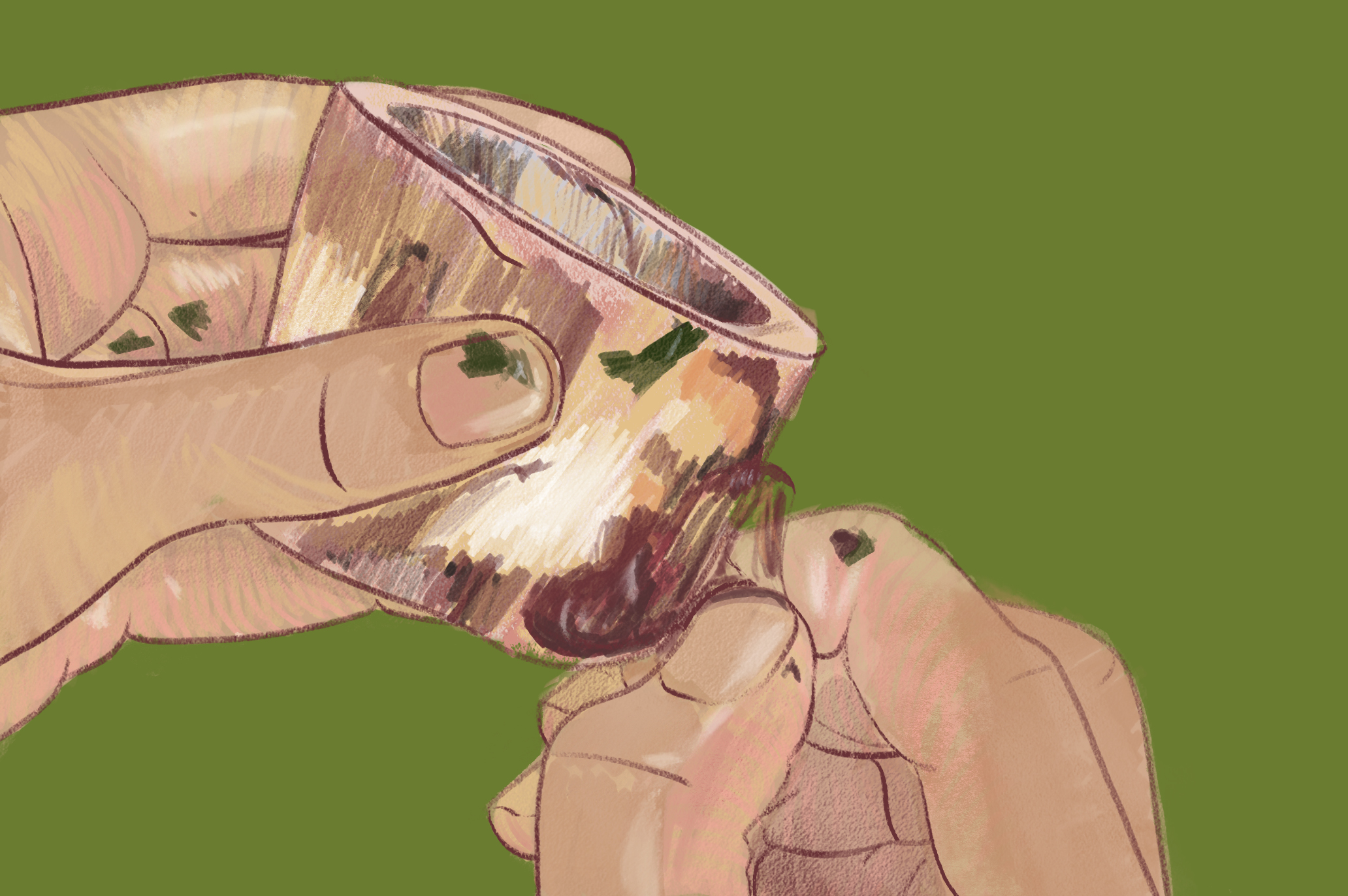
MS: I usually understand diasporas as being groups of people or identities that are removed from their roots, whether migratory or resettled elsewhere, which tends to come with multiculturalism and sort of creolized new foods, traditions, etc. How does the idea of diaspora influence the food you work with and meals you share?
DM: I think I might be reluctant to call my work diasporic, or even queer. Perhaps I’ll call my work a practice of placemaking. The Filipino side of my family moved to the United States in the 70’s. I was born in New Jersey, I grew up in a neighborhood I can’t afford anymore, I’ve lived in six different cities, I never feel settled, and that all feels important to my practice. But I’ve spent the last few years trying to distance myself from a diasporic narrative, it feels like one I can’t claim, a trauma that isn’t mine, even when thinking about intergenerationality and the ways that I can carry a migratory experience in my body. I think a lot about the expectations around my work as a queer southeast asian person, as a femme, as a mixed race person, as someone who works across mediums and research methods. The ways that these are liminal spaces to occupy, and how diaspora, as a liminal space itself is what people expect of me, how my work is categorized. How do I push against this? I do not want to actively perpetuate bearing witness to trauma as core to my practice. This requires a high pain threshold, a retraumatizing that I am not willing to put myself, my family, or my audiences through. Although there is something cathartic about making from spaces of loss, it feels more fruitful to aim toward making from spaces of joy and celebration, not scarcity.
Resisting the expectation of diaspora art reminds me of a text written by Zarina Muhammad for The White Pube (written in specific context of South Asian diaspora art but I think more widely applicable):
“Diaspora Art feels like it’s still stuck on dealing with the condition of duality in which the Diasporic body rests … It is fundamentally a shallow replicative representation, because while it claims to engage with a baseline fundamental of the South Asian experience … the fact that it’s purely an aesthetic engagement reduces this interaction to vague universality that skims over sticky intersections.”
Muhammad goes on to say: “I argue Diaspora Art capitulates to the white gaze’s well-intentioned drive to understand, sympathise, but never to overthrow, act, or change. The audience it hits is happy with the liberatory or celebratory language of the aesthetics, as long as those aesthetics are inert in their demands. This inertia in the aesthetics deployed by Diaspora Art is actively praised and weaponised by this individual white desire to ~understand~.”
MS: Do you see your resistance to making art that gets classified as “diaspora art” in line with this kind of reasoning?
DM: Totally totally! In a lot of ways, diaspora feels like a really othering term, a way for a gaze outside of myself to interpret, or come close to the work, without actually understanding it. I would say that any classification functions this way. Whether my work is labeled queer, or asian, or diasporic, or whatever. It’s for no one else’s use except for those who exist outside of that experience. Of course, not to knock anyone who finds comfort in classification, but for me, I make the work that I make and I use the materials that I use because it is what brings me joy, it is what brings me closer to myself.
MS: You’ve said before that all of your work is about feeding and being fed- can you expand on this? How do you use food as a means of connection and nurture for a community or more intimate relationship?
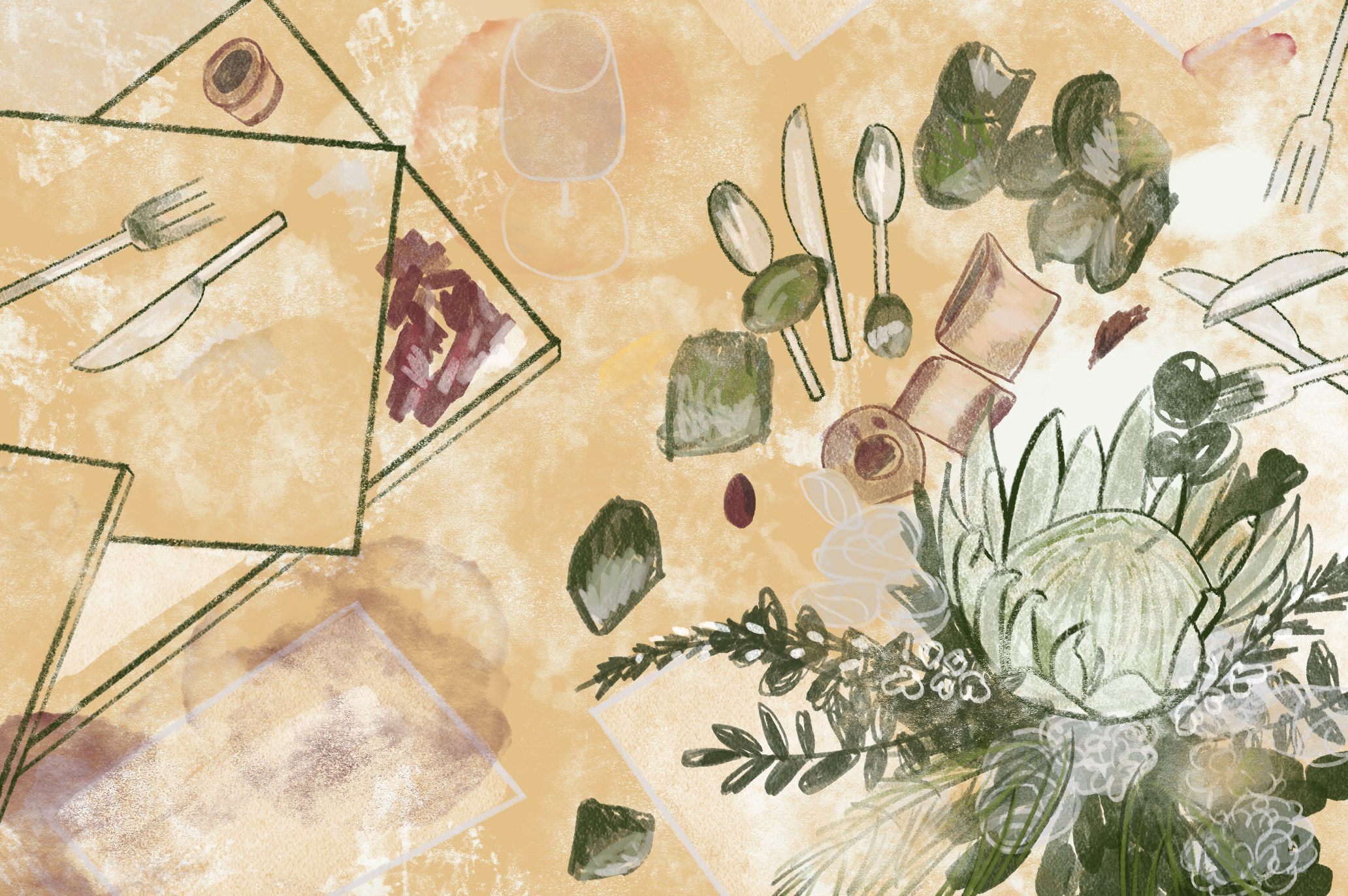
DM: When I think about the ways I know how to love, I immediately think about cooking. What does it mean to nourish yourself and others in all aspects of that word? To feed and to be fed is an act of kindness at its core, in many ways it is erotic, it is also our most basic need. Whether this means the way we interact with an ingredient or the way we share in the bounty of our labor, it is all a form of intimacy. It is a form of intimacy that does not require words, but rather is an elemental gesture of tongues, of hands.
MARROW concluded with three buttery galettes filled with grilled nectarines, flaked with sea salt and topped with a lavish helping of a rich whipped cream. These last few bites played with warm and cold, sweet and sour, juicy and soft, and then reduced me to eating the whipped cream straight out of the bowl on its own. As we passed around the serving board I looked at the white sheets surrounding us, now wrinkled and stained by fingertips, at what now looked like a dissection table with a flower centerpiece. The previously pristine paper menus and poems were strewn across the platform, kept from flying by glasses and forks, smudged by the ingredients they sought to represent or prepare us for. This excavation lasted roughly two hours and at its end, I thought about all of the produce we had just dismembered, and felt very pleasantly full.
Thank you Devyn for your generosity and thoughtfulness.
Featured Image: Illustrated water flowing from two cupped hands down into a serving bowl of sabaw (soup). There are several ingredients in the bowl including knobs of ginger and cloves of garlic that are falling into the bowl. The backdrop is a flat olive-green color. Illustration by Kiki Dupont.

Maya is currently interested in city mapping, using interview as a medium, beekeeping, geopolitical surveillance, and exploring a queer post-Soviet Jewish culture. Maya obtained their BA at American University and MA at the University of Westminster and once made delicious elder flower cordial in rural Bulgaria.
